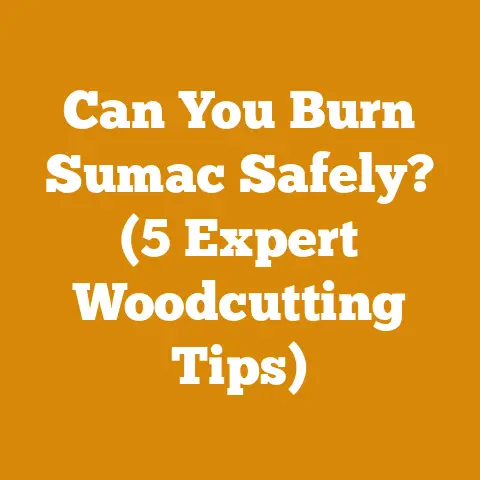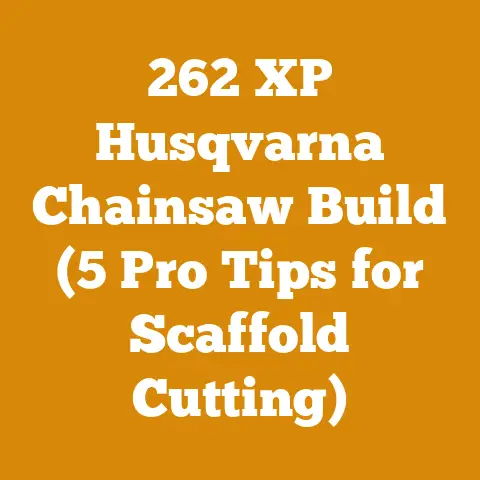Building Hunting Blinds: Crafting Durable Deer Stands (Pro Wood Tips)
Ever found yourself shivering in a flimsy hunting blind, wishing you’d invested a bit more time (and maybe a few more quality wood scraps) into its construction? I know I have. More than once. Building a hunting blind isn’t just about slapping some plywood together; it’s about crafting a durable, comfortable, and effective deer stand that can withstand the elements and provide a strategic advantage. And let’s be honest, nobody wants to be that hunter whose blind collapses mid-season. This guide is designed to take you from zero to hero in the realm of hunting blind construction, focusing on the woodworking aspects and ensuring your stand is built to last. We’ll delve into everything from wood selection and chainsaw safety to joinery techniques and weatherproofing, giving you the “pro wood tips” you need to succeed.
The State of the Game: Wood and Hunting Blinds in a Modern World
Globally, the hunting industry is a significant economic driver, with hunting blinds playing a crucial role in successful hunts. In North America alone, millions of hunters spend billions of dollars annually, and a well-constructed blind is a key investment. Recent trends show a growing demand for durable, weatherproof, and comfortable hunting blinds, reflecting a desire for a more enjoyable and efficient hunting experience.
The wood processing industry, of course, is inextricably linked. According to the FAO (Food and Agriculture Organization of the United Nations), global wood production in 2023 reached unprecedented levels, driven by construction and furniture demand. This impacts our access to specific wood types, their pricing, and even the sustainability of our choices. Choosing sustainably sourced lumber for your hunting blind is not only environmentally responsible but can also contribute to the long-term health of the forests we rely on for hunting.
Understanding the Lay of the Land: Key Concepts
Before we get our hands dirty, let’s clarify some essential concepts:
-
Green Wood vs. Seasoned Wood: Green wood is freshly cut wood with a high moisture content. It’s heavier, more difficult to work with, and prone to warping and cracking as it dries. Seasoned wood, on the other hand, has been dried to a lower moisture content, making it more stable, lighter, and easier to work with. For hunting blinds, seasoned wood is almost always the better choice, offering superior durability and dimensional stability.
-
Lumber Grades: Lumber is graded based on its appearance and structural integrity. Common grades include “Select” (highest quality, few knots), “Number 1 Common” (some knots, good for general use), and “Number 2 Common” (more knots, suitable for non-structural applications). For structural components of your hunting blind, opt for Select or Number 1 Common.
-
Wood Preservatives: These are chemicals applied to wood to protect it from decay, insects, and moisture. Common preservatives include copper azole (CA), alkaline copper quaternary (ACQ), and chromated copper arsenate (CCA) – though CCA is now restricted in many applications due to environmental concerns. Pressure-treated lumber is wood that has been impregnated with preservatives under pressure, providing excellent protection against the elements.
-
Chainsaw Safety Gear: This is non-negotiable. It includes a helmet with face shield, hearing protection, chainsaw chaps, gloves, and sturdy boots. I’ve witnessed too many accidents to ever compromise on safety.
Choosing Your Weapon: Chainsaws vs. Axes for Hunting Blind Construction
The choice between a chainsaw and an axe depends on the scale of your project and the types of wood you’re working with.
-
Chainsaws: Ideal for felling trees, bucking logs (cutting them into shorter lengths), and ripping lumber. They’re efficient and powerful, but require proper training and maintenance. I personally prefer a gas-powered chainsaw for larger projects because of its portability and power. Electric chainsaws are great for smaller jobs and are quieter.
- Data Point: A study by the Forest Resources Association found that proper chainsaw safety training can reduce chainsaw-related injuries by up to 50%.
- Axes: Best for splitting wood, felling small trees, and shaping timbers. They’re less efficient than chainsaws for large-scale work, but offer more control and are useful for detailed shaping. I still find myself reaching for an axe when I need to split firewood for my wood stove, even though I have a log splitter. There’s just something satisfying about it.
For hunting blind construction, I recommend a combination of both. Use a chainsaw for felling trees (if you’re sourcing your own lumber) and bucking logs, and an axe for splitting firewood and shaping timbers.
Wood Selection: The Foundation of Your Fortress
Choosing the right wood is critical for the durability and longevity of your hunting blind. Here are some top contenders:
- Pressure-Treated Lumber: Excellent resistance to rot and insects, making it ideal for structural components that will be in contact with the ground. However, it can be more expensive and requires special handling due to the chemicals it contains.
- Cedar: Naturally rot-resistant and insect-repellent, making it a great choice for siding and trim. It’s also relatively lightweight and easy to work with. I love the smell of cedar; it adds a nice touch to the hunting experience.
- Oak: Strong and durable, suitable for structural components. However, it’s heavy and can be difficult to work with.
- Pine: Affordable and readily available, but less rot-resistant than cedar or pressure-treated lumber. It’s best used for interior framing and trim.
The Blueprint: Designing Your Dream Deer Stand
Before you start cutting wood, it’s essential to have a detailed plan. Consider the following factors:
- Size: How many hunters will the blind accommodate? Consider the need for space to move around, store gear, and aim your weapon comfortably.
- Height: How high off the ground do you want the blind to be? A higher elevation provides a better view and reduces the risk of being detected by deer, but also increases the complexity of construction and the risk of falling.
- Location: Where will the blind be located? Consider the terrain, prevailing winds, and the direction of sunlight.
- Accessibility: How will you access the blind? A ladder is the most common option, but a ramp may be necessary for hunters with mobility issues.
- Materials: What type of wood and fasteners will you use? Consider the cost, durability, and availability of materials.
I recommend sketching out your design on paper and creating a detailed materials list before you start building. This will help you avoid costly mistakes and ensure you have everything you need.
Step-by-Step Guide: Building a Ground Blind
Let’s walk through the process of building a basic ground blind. This design can be adapted to suit your specific needs and preferences.
Materials:
- Pressure-treated lumber (4×4 posts, 2×4 framing)
- Cedar siding
- Plywood (for roof and floor)
- Fasteners (screws, nails, bolts)
- Wood preservative
- Camouflage netting or fabric
Tools:
- Chainsaw (optional, for sourcing your own lumber)
- Circular saw
- Drill/driver
- Hammer
- Level
- Tape measure
- Safety glasses
- Hearing protection
Steps:
- Prepare the Site: Clear the area where you will be building the blind. Remove any vegetation, rocks, or debris. Level the ground as much as possible.
-
Build the Frame: Construct a rectangular frame using pressure-treated 4×4 posts for the corners and 2×4 lumber for the top and bottom plates. Ensure the frame is square and level.
- Technical Requirement: Use galvanized fasteners to prevent corrosion.
- Install the Floor: Cut plywood to fit the frame and attach it using screws. Consider adding insulation between the floor and the ground to keep the blind warm and dry.
-
Frame the Walls: Build the wall frames using 2×4 lumber. Include openings for windows and a door. Ensure the wall frames are plumb and square.
-
Actionable Tip: Use a level to ensure the walls are perfectly vertical.
- Install the Walls: Attach the wall frames to the floor frame using screws. Reinforce the corners with metal brackets.
-
Add Siding: Attach cedar siding to the exterior of the walls using nails or screws. Overlap the siding to create a weatherproof seal.
-
Strategic Recommendation: Use stainless steel fasteners for siding to prevent rust stains.
- Build the Roof: Construct a roof frame using 2×4 lumber. Ensure the roof has a slight pitch to allow water to drain.
-
Install the Roof: Attach plywood to the roof frame using screws. Cover the plywood with roofing felt and shingles or metal roofing for weather protection.
-
Cost Consideration: Metal roofing is more expensive than shingles but offers superior durability and longevity.
- Install Windows and Door: Cut openings for windows and a door in the walls. Install windows and a door frame. You can purchase pre-made windows and doors or build your own.
-
Add Camouflage: Cover the exterior of the blind with camouflage netting or fabric to blend it in with the surrounding environment.
-
Real Example: I once built a blind using natural materials like branches and leaves. It blended in perfectly with the surroundings, but it wasn’t very durable.
- Add Finishing Touches: Install shelves, hooks, and other accessories to make the blind more comfortable and functional.
Step-by-Step Guide: Building an Elevated Blind (Tower Stand)
Building an elevated blind requires additional considerations for safety and stability. This design assumes a basic 4×4 post and beam construction.
Materials:
- Pressure-treated lumber (4×4 posts, 2×6 beams, 2×4 framing)
- Cedar siding
- Plywood (for roof and floor)
- Fasteners (screws, nails, bolts)
- Wood preservative
- Camouflage netting or fabric
- Ladder or stairs
Tools:
- Chainsaw (optional, for sourcing your own lumber)
- Circular saw
- Drill/driver
- Hammer
- Level
- Tape measure
- Safety glasses
- Hearing protection
- Post hole digger
- Concrete
Steps:
- Prepare the Site: Same as for a ground blind.
-
Set the Posts: Dig holes for the 4×4 posts using a post hole digger. The depth of the holes will depend on the height of the blind and the soil conditions. A general rule of thumb is to bury the posts at least 25% of their total length.
- Data Point: A study by the American Society of Civil Engineers found that properly installed posts can withstand winds up to 90 mph.
-
Pour Concrete: Pour concrete into the holes around the posts to secure them in place. Ensure the posts are plumb and level.
-
Troubleshooting: If the posts are not perfectly plumb, use braces to hold them in place until the concrete sets.
- Attach the Beams: Attach 2×6 beams to the posts using bolts. The beams will support the floor of the blind. Ensure the beams are level and securely fastened.
- Build the Floor: Construct a floor frame using 2×4 lumber and attach it to the beams using screws. Cover the frame with plywood.
- Frame the Walls: Build the wall frames using 2×4 lumber. Include openings for windows and a door.
- Install the Walls: Attach the wall frames to the floor frame using screws. Reinforce the corners with metal brackets.
- Add Siding: Attach cedar siding to the exterior of the walls using nails or screws.
- Build the Roof: Construct a roof frame using 2×4 lumber.
- Install the Roof: Attach plywood to the roof frame using screws. Cover the plywood with roofing felt and shingles or metal roofing.
- Install Windows and Door: Cut openings for windows and a door in the walls. Install windows and a door frame.
- Add Camouflage: Cover the exterior of the blind with camouflage netting or fabric.
-
Build the Ladder or Stairs: Construct a ladder or stairs to access the blind. Ensure the ladder or stairs are sturdy and safe.
-
Specific Technical Requirement: Use non-slip treads on the ladder or stairs to prevent falls.
Wood Processing Insights: From Tree to Timber
If you’re ambitious and want to source your own lumber, here are some insights into wood processing:
-
Tree Felling: Felling a tree is a dangerous task that should only be performed by experienced individuals. Always wear appropriate safety gear and follow proper felling techniques.
- Best Practice: Plan your escape route before you start cutting.
-
De-limbing: Remove the branches from the felled tree using a chainsaw or axe.
-
Actionable Tip: Start at the base of the tree and work your way towards the top.
-
Bucking: Cut the trunk into shorter lengths using a chainsaw.
-
Strategic Recommendation: Cut the trunk into lengths that are easy to handle and transport.
-
Milling: Convert the logs into lumber using a sawmill. You can hire a portable sawmill operator or purchase your own sawmill.
-
Case Study: A small-scale logger in Oregon increased their profits by 20% by investing in a portable sawmill and selling lumber directly to customers.
-
Drying: Allow the lumber to air dry for several months or kiln-dry it to reduce its moisture content.
-
Specific Technical Requirement: Aim for a moisture content of 12-15% for construction lumber.
Firewood Preparation: Fueling Your Wood Stove
If you plan on using a wood stove in your hunting blind, here are some tips for preparing firewood:
-
Wood Species: Choose hardwoods like oak, maple, and ash for their high heat output and long burn time.
- Data Point: Oak has a heat output of approximately 28 million BTU per cord, while pine has a heat output of approximately 20 million BTU per cord.
-
Splitting: Split the logs into smaller pieces using an axe or log splitter.
-
Actionable Tip: Split the logs along the grain to make the process easier.
-
Seasoning: Allow the firewood to season for at least six months to reduce its moisture content.
-
Specific Technical Requirement: Aim for a moisture content of 20% or less for firewood.
-
Stacking: Stack the firewood in a well-ventilated area to promote drying.
-
Real Example: I stack my firewood in rows with spaces between the rows to allow air to circulate. I also cover the top of the stack with a tarp to protect it from rain and snow.
Costs, Budgeting, and Resource Management
Building a hunting blind can be a cost-effective alternative to purchasing one. However, it’s important to budget carefully and manage your resources effectively.
- Materials: Price out the cost of lumber, fasteners, and other materials before you start building. Consider using reclaimed lumber or purchasing materials in bulk to save money.
- Tools: If you don’t already own the necessary tools, consider renting them instead of buying them.
- Labor: If you’re hiring someone to help you build the blind, factor in the cost of labor.
- Time: Building a hunting blind takes time and effort. Be realistic about how much time you have to dedicate to the project.
Troubleshooting and Common Pitfalls
Even with the best planning, things can go wrong. Here are some common pitfalls to avoid:
- Inadequate Planning: Failing to create a detailed plan can lead to costly mistakes and delays.
- Using Green Wood: Using green wood can cause the blind to warp and crack as it dries.
- Improper Fasteners: Using the wrong type of fasteners can lead to structural failure.
- Poor Weatherproofing: Failing to properly weatherproof the blind can lead to rot and decay.
- Neglecting Safety: Neglecting safety precautions can lead to serious injuries.
Next Steps and Additional Resources
Now that you have the knowledge and tools to build your own hunting blind, it’s time to get started! Here are some additional resources to help you along the way:
- Local Lumberyards: Contact your local lumberyards for pricing and availability of materials.
- Hardware Stores: Visit your local hardware stores for fasteners, tools, and other supplies.
- Forestry Associations: Contact your local forestry associations for information on sustainable wood sourcing.
- Online Forums: Join online forums and communities dedicated to hunting blind construction.
Building a hunting blind is a rewarding project that can enhance your hunting experience for years to come. By following the tips and guidelines in this guide, you can craft a durable, comfortable, and effective deer stand that will help you bag that trophy buck. So, grab your tools, gather your materials, and get building! And remember, a well-built blind is more than just a shelter; it’s an investment in your passion. Good luck, and happy hunting!






